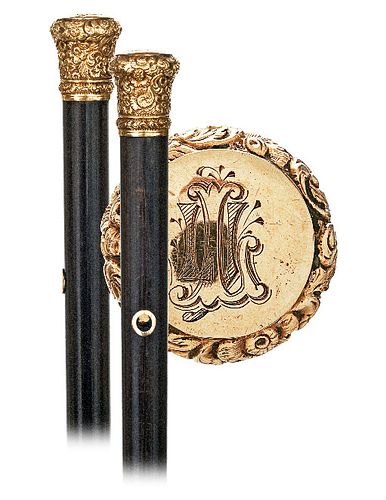Gold New England Marine Cane
Lot 27
About Seller
Kimball Sterling
125 West Market Street
Johnson City, TN 37604
United States
Family-owned and family-run Johnson City Tennessee auction business for 25 years. Selling antiques and collectables for 38 years. Kimball M. Sterling, Inc. was founded and is owned by Kimball and Victoria Sterling, time and again, they have laid solid claim to world-wide attention and renown with an...Read more
Categories
Estimate:
$450 - $600
Absentee vs Live bid
Two ways to bid:
- Leave a max absentee bid and the platform will bid on your behalf up to your maximum bid during the live auction.
- Bid live during the auction and your bids will be submitted real-time to the auctioneer.
Bid Increments
| Price | Bid Increment |
|---|---|
| $0 | $10 |
| $100 | $25 |
| $500 | $50 |
| $1,000 | $100 |
About Auction
By Kimball Sterling
Oct 10, 2020
Set Reminder
2020-10-10 11:00:00
2020-10-10 11:00:00
America/New_York
Bidsquare
Bidsquare : Cane Auction- World Class
https://www.bidsquare.com/auctions/kimball-sterling/cane-auction--world-class-5622
This is a European single owner collection with many fine canes from different categories, All are top-notch canes in fine condition. Kimball Sterling kimballsterling@earthlink.net
This is a European single owner collection with many fine canes from different categories, All are top-notch canes in fine condition. Kimball Sterling kimballsterling@earthlink.net
- Lot Description
Ca. 1850-Small 18 karat yellow gold knob fashioned in a well-proportioned classic taste and elaborately hand chased and engraved with a plethora of flowers and scrolls topped by a plain round shield with engraved initials of its first owner and ending with an integral and matching multiple ring collar. So far, so good, however, what makes this cane very special is its gently tapering baleen shaft with gold eyelets and a brass ferrule, which displays throughout the specific layered structure of the noble material of the ocean and its coveted dark brown-greenish hues. Hardly encountered in the widespread cane repertoire, this first rate dress cane with apparent New England flavor is an upscale collectable with direct ties to the golden age of whaling. Indeed, ever since the Mayflower deposited the Pilgrim Fathers on the shores of Cape Cod in 1620, New Englanders have been fascinated by their marine heritage with the marine canes flourishing at a time when whaling was a respectable and entirely natural part of life. An excellent condition adds to its desirability. H. 1” x ¾”, O.L. 35” Baleen or whalebone is a filtering structure in the mouth of most whales, which they use to feed by sieving small animals from large mouthfuls of seawater. Instead of teeth, these whales have rows of baleen plates in the upper jaw – flat, flexible plates with frayed edges, arranged in two parallel rows, looking like combs with thick hair at the end of each comb tooth. Baleen is not in fact composed of bone, but of the protein keratin, the same substance as hair, horn, scales, claws and nails. Baleen whales use these combs for filter feeding. Depending on the species, a baleen plate can be 0.5 to 3,5 meters (1,6 to 11 ft) long, and weigh up to 90 kilograms (200 lb). Its hairy fringes are called baleen hair or whalebone-hair. Baleen plates are broader at the gumline. The plates have been compared to sieves or Venetian blinds. Baleen whales are characterized by having baleen plates for filtering food from water, rather than having teeth. This distinguishes them from the other suborder of cetacean, the toothed whales or Odontocete. For few up to date annotations on Marine canes extending to the present perspective to the art of the fisherman himself refer to Youssef Kadri’s book, The Mandel Cane Collection.
- Shipping Info
-
Each auction has different shipping terms but the buyer always pays.Canes:After payment has been received we will ship in-house the domestic orders, International bidders will be shipped by the UPS store (423-979-7122) and email store4146@theupsstore.com After we receive payment we will deliver to the UPS store and they will contact you.Other Auctions:After payment has been received and cleared we will deliver your items to the UPS Store and they will quote and prepare for shipping.phone (423-979-7122 and email store4146@theupsstore.com
-
- Buyer's Premium



 EUR
EUR CAD
CAD AUD
AUD GBP
GBP MXN
MXN HKD
HKD CNY
CNY MYR
MYR SEK
SEK SGD
SGD CHF
CHF THB
THB


















